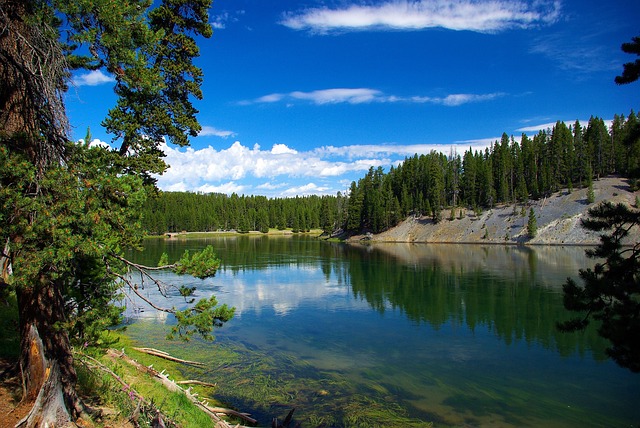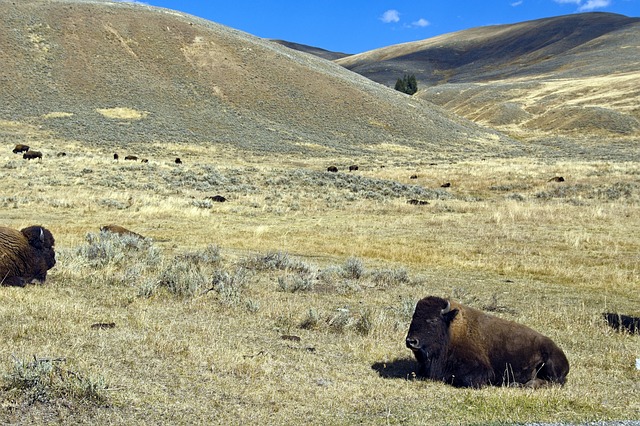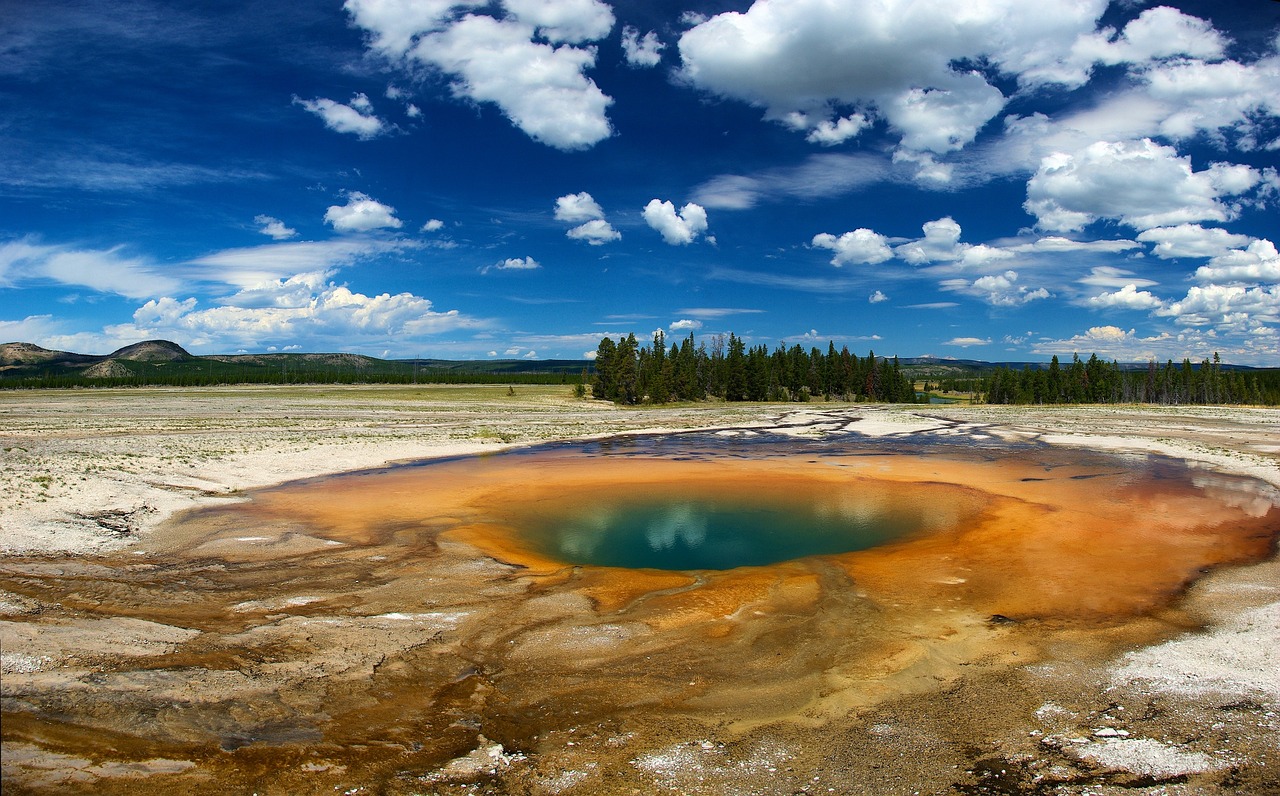Yellowstone National Park is more than just the first national park in the US. It was also the first national park in the world. Another interesting thing about Yellowstone is that it is one of a kind. Geothermal activity is very strong in this area because it is on top of a supervolcano. Also, more wild animals live there than almost anywhere else in the US.
It is true that this park is one of the few places where you can regularly see rare animals like gray wolves and grizzly bears. A list of Yellowstone National Park’s most popular tourist spots:
10 Most Captivating Sights of Yellowstone National Park
1. Mount Washburn
Mount Washburn was the leader of the Washburn-Langford-Doane Expedition that explored Yellowstone Park in 1870. This hill was named for him. Many people love to walk in Yellowstone, and Mount Washburn is one of their favorite spots. The mountain can be reached by two tracks. One starts at the Dunraven Pass Trailhead, and the other at the Chittenden Road parking lot. Both have stunning views of the area, but during the busiest tourist season, they can get busy. Some walkers have trouble with the high elevation, even though these trails are thought to be pretty easy. Mountain goats, bears, and other wild animals can sometimes be seen from these paths.
2. Hayden Valley

People love to go to this valley to see wildlife because it is in the middle of everything. You can often see big groups of buffalo grazing in the fields of this valley. You can also often see elk, pronghorn antelopes, and bears. Luckily, Hayden Valley has a lot of turnouts where people can park and get a better view of the beautiful valley and its animals. People who like to hike can also get a close look at the beautiful area from two trails in Hayden Valley. Along the Yellowstone River, the Hayden Valley Trail goes from Yellowstone Lake to the Grand Canyon of Yellowstone. A wagon road leads to the Mary Mountain road, which is said to be the most popular trail in the park. When hiking in the valley, be careful because bears like to hang out here.
3. West Thumb Geyser Basin
On the shores of Yellowstone Lake is the West Thumb Geyser Basin. Another well-known geothermal feature in Yellowstone can be found in this geyser area, even though it is one of the smallest in the park. Before 1911, fishermen in Yellowstone Lake near this geyser would sometimes drop their catch, still on the hook, into the hot water of the cone, cooking it alive. In 1911, that was made illegal. There are also several other geysers, boiling mud pots, and hot springs in the West Thumb Basin. The Abyss Pool is the park’s deepest pool. This area is in West Thumb Bay, which got its name from the fact that early explorers said Yellowstone Lake looked like a hand. People said that this western bay looked like the thumb of that hand.
4. Yellowstone Lake

This lake is the biggest freshwater lake in North America that is over 7,000 feet (2,100 meters) long. It’s also a very strange lake. Geysers, hot springs, and valleys that are up to 390 feet (120 meters) deep are below the surface. It has also been reported that the water in Yellowstone Lake’s Mary Bay is 252 degrees F in some places. This body of water, on the other hand, mostly looks like any other lake in the United States from the top. Fishing (with a ticket) and boating are both allowed on Yellowstone Lake, which is home to many types of fish, such as cutthroat trout and longnose suckers. People who want to stay close to the lake should book a room at either the Lake Yellowstone Hotel, which was built in 1891, or the Lake Lodge Cabins.
5. Norris Geyser Basin
It is the largest geyser basin in Yellowstone. It is also the hottest and has some very rare acid geysers. The Porcelain Basin and the Back Basin are the two parts that makeup Norris. There are hundreds of geothermal features grouped together in the Porcelain Basin area, but they are spread out in the wooded Back Basin. The largest geyser in the world, the Steamboat Geyser, is one of the interesting things about the Back Basin. The steamboat can shoot water up to 120 meters (300 to 400 feet) in the air. It is hard to predict when it will explode, so there is no way to know for sure. The Norris Geyser Basin is a place that changes all the time. For instance, the Echinus Geyser used to pop about every 35 to 75 minutes, which was a very regular show. That changed in 1998, though. It no longer spouts very often.
6. Lamar Valley

This part of Yellowstone is sometimes called “America’s Serengeti” because it has some of the best wildlife views in the park. It is home to big groups of buffalo and is also the best place for tourists to see wolves. This valley is home to at least one wolf pack, and sometimes two. One of the most well-known packs in the park, the Druids, used to live in the Lamar Valley. Pronghorn antelope, elk, wolves, and bears are some of the other animals that can often be seen in the Lamar Valley. Early in the morning or late at night are the best times to see bears and wolves.
7. Mammoth Hot Springs
Steaming hot water runs over travertine terraces at Mammoth Hot Springs, making a beautiful but strange scene. Some people have even said that Mammoth Hot Springs looks like a cave that has been turned upside down. The Upper and Lower Terraces make up the two parts of the Mammoth Hot Springs area. There are a lot of hot springs and interesting-looking rock formations in each area. There are also good chances to see elk in this part of the park. They often hang out near the tourist center for Mammoth Hot Springs. Visitors should always stay away from them, even if they look friendly. This is especially important during the fall rutting season when the males can be very dangerous. There have also been times when female elk with babies have charged people who come too close to their young.
8. Midway Geyser Basin

One of the smallest basins in Yellowstone is Midway, which is where its name comes from. It is between the Upper and Lower Geyser Basins. It also has the Grand Prismatic Hot Spring, which is the natural feature in the park that people take the most pictures of. This huge hot spring, which is 120 feet (37 meters) deep, is famous for its strange, bright colors. In the middle, there is a beautiful cerulean color that looks beautiful on its own. But it’s not by itself. There are bright reds, yellows, and oranges around the blue instead. Excelsior, which used to be the world’s biggest geyser, is also in this geyser area. This geyser hasn’t opened since the 1880s. It used to shoot water up to 300 feet high. It is still, however, a hot spring that is working.
9. Upper Geyser Basin
It’s possible that the upper geyser basin is Yellowstone’s most famous spot. It has the most hot springs of any place in the world and is the biggest geyser basin in the park. It is also where Yellowstone National Park’s most famous fountain, Old Faithful, is located. People love this geyser because the park can pretty correctly guess when it will erupt, and the breaks between eruptions are short, lasting only 60 to 110 minutes. This area has more than 150 geysers, hot springs, and fumaroles, as well as Old Faithful. A nice path through the Upper Geyser Basin was made by the park to make it easy to see the many interesting geothermal features in the area.
10. Grand Canyon of the Yellowstone

The strong Yellowstone River carved out this rough and colorful tunnel over many years. The Upper Falls and the Lower Falls are the most famous sights in the Grand Canyon of Yellowstone. They are both very beautiful and big. The Lower Falls fall about 300 feet (90 meters) and are twice as high as Niagara Falls. The Upper Falls fall 109 feet (33 meters). In the area, you can also see a number of hot springs and steam sources. Canyon Village has hotel rooms, RV and tent sites, and other places to stay for people who want to stay in the area.



